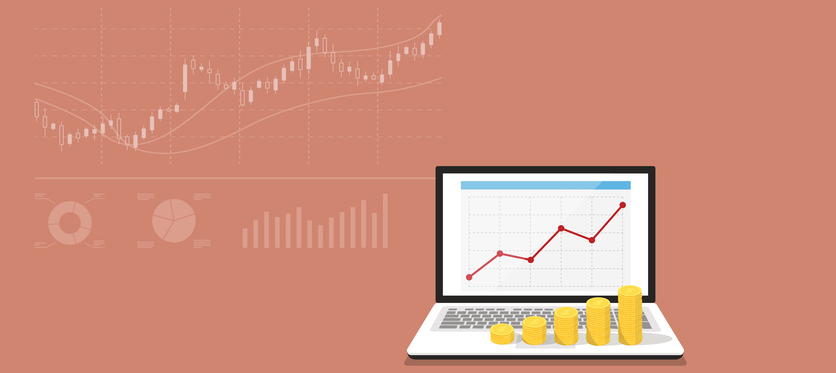E-mini futures trading is very popular due to its low cost, wide market selection and access to leverage. In this E-mini futures tutorial we explain the definition, history and structure, before moving on to the benefits of e-mini futures vs stocks, forex and options day trading. Along the way, trader options, trading hours and margin requirements will also be broken down.
What is an E-Mini?
Although there are other E-mini contracts, E-mini is usually the abbreviation of E-Mini S&P 500, with the ticker symbol ES. Basically, it is a stock market index futures contract listed on the Chicago Mercantile Exchange (CME). The value of a single contract is 50 times that of the S & P stock index. So the contract size is reduced while still following the same index. It’s also worth noting that, as will be discussed in detail below, there are several other E-mini contract options, from Russell 2000 futures to S&P MidCap 400 and Dow Jones futures. End date
Contract transition to the next active contract. However, when the expiration calendar shows, it expires every quarter, usually on the third Friday of March, June, September and December. Having said that, it is the more important contract transition date. Transitions take place on the second Thursday, March, June, September and December. Although if the date is Friday, the first Thursday will be the transition. You can find upcoming details on the expiration and settlement of S&P 500 options by heading to the official CME website.
E-Mini option
Unsurprisingly, the E-mini S&P 500 contract was so successful that CME and other exchanges introduced more than 40 other mini futures contracts, including:
- NASDAQ 100 (symbol NQ futures)
- NASDAQ Composite (symbol QN)
- S&P Midcap 400 (symbol EMD)
- S & P Smallcap 600 (symbol SMC
- Dow (symbol YM)
- Russell 1000 (symbol RF2)
- Russell 2000 (symbol RF2)
- NASDAQ Biotech (symbol BQ)
- Commodities – Gold, silver, copper, wheat, corn, soybeans, natural gas, heating oil and light crude oil futures contracts.
- Forex – Long list of prices against the US Dollar, including Euro, British Pound, Japanese Yen, Swiss Franc, Canadian Dollar, Australian Dollar and Chinese Renminbi.
- Options – On S&P 500 and NASDAQ 100 Emini Issues.
Further afield, you can also find minis of the Nikkei 225, Nifty 50 and FTSE 100 indices. However, despite some mini options, the S&P 500 E-mini still accounts for the majority of trading volume. In fact, of more than 40 other mini-contracts, only 10 have a daily volume that exceeds 1,000 contracts. Also the attention price, volume, volatility, contract size and other specifications will all change between each product and market.
Who Sells E-Minis?
If you decide to start trading in E-mini index futures, who are the contenders?
- 15 High Frequency Trading Firms represent about one third of the E-mini market.
- Around 6,000 day traders or professional positions make up almost two-thirds of the market.
- About 6,000 amateurs sell about one contract per trade, every day, representing only 1% of the total.
Why E-Minis Trading?
There are several factors that make E-minis a great intraday trading vehicle, including:
- Global – You can trade a global equity index portfolio from just one market.
- Low costs – Deep liquidity and a tight spread of offers can help keep costs down. In addition, alternative equity index futures can help save on margin.
- Leverage – Leverage can help you buy and sell large contracts with minimal capital. This means you have more options when you open your real-time S&P 500 futures bar chart.
- Access – With nearly 24-hour access, you can trade as events unfold. There are also many news sources and other online resources available. This means you can quickly identify gold futures or the NASDAQ 100 symbol when key events occur and trade accordingly.
- Options – The number of products and options has increased significantly. For example, you can now delve into the technologies and utilities of select futures sectors, on top of the more standard E-mini contracts.
- Resources – Today’s brokers offer many additional resources, from advanced charting packages to in-depth user guides. All that can help you decipher Dow Jones charts, Emini ticker quotes and values, for example.
Risk
While there are obvious benefits, you should also be aware of the risks before you check the value of the S&P 500 and the price of crude oil, including:
- Electronic commerce – Speed is not always good news in the electronic market, as E-minis can move quickly. This high rate of volatility can be dangerous, especially for new traders.
- Overload – With so many opportunities and electronic interfaces, it can be tempting to keep trading and putting money after a big loss. This is especially true when there is access to readily available historical NASDAQ 100 data, for example. This can all mean that those without discipline risk losing a lot of capital in a row.
Both the pros and cons of these futures have been explained. This will help you approach the list of E-minis S&P 500 futures symbols with caution.
E-Mini Futures vs Stocks, Options & Forex
You have gold contracts, major currency pairs, copper futures, binary options and more. So how do you know which market to focus your attention on? Let’s see:
- Stock – There is certainly no shortage of options with stock. However, most of the time they simply track the overall market. In addition, just one news event can send prices plummeting. Asserting an edge can also prove challenging, especially when everyone sees the same NASDAQ forecast on Yahoo Finance.
- Options – Although they are meant to be easy, they usually aren’t. You often need to get the direction, size and timing of the moves right. Not to mention, there are various trading strategies to get your head around.
- Commodity – This is a professional house. You often need to have a niche and stay up to date on all things milk, for example. In addition, with commodities, you often don’t experience volatility or too much.
- Forex – Although FX trading is very popular, volume data is incomplete. Until the banks are ready to share all the volume data in real time, you may always be a step behind trying to keep up with average and professional trade measurements.
Margin Requirements
Just like the E-mini S&P 500 futures contract prices are margin requirements. Of course, these requirements will vary among brokers. However, there are three key rates that are important:
- Transaction initiation margin – This is the account balance you need to enter E-mini intraday orders. This can be anywhere from $1,000 up to $2,750. Note that market fluctuations can also affect prices.
- Overnight starting margin – This is the account balance you need to trade overnight or during after-hours sessions. Usually the price ranges from $4,500 to $5,250.
- Account opening minimum – This is just how much you need to open a futures account. You may need anywhere from $5,000 to $10,000.
Keep in mind that you don’t need to see how many 1 Emini contracts and margin rates are included. Volume traders, for example, will want to consider the trading platform and the additional resources it offers. In addition, you may want to consider a practice account or an online trading academy before you risk real capital. Both will help you develop effective trading strategies while building market confidence. Finally, you may want to consider the margin rate in conjunction with other rules and regulations. For example, will low margin conditions cause you to trade more and then run pattern day trader rules?
Trading Hours
S&P 500 E-mini futures trading hours run Sunday through Friday 5:00 PM to 4:00 PM CT. However, there is a 15-minute trading gap between 15:15 and 15:30 CT. In addition, daily maintenance occurs between 16:00 and 17:00 CT. Trading hours are divided into two sessions:
- The day trading session starts at 08:30 and ends at 15:15 CT.
- After-hours trading begins at 15:30 and lasts until the next day’s session opens.
As the E-mini S&P 500 historical data and live charts show, the largest volume is seen during the day’s session. After that, the release of data before the open day session also triggered important activities. Also, any major news from Europe could cause an increase in trading. NASDAQ E-minis notes and other mini contracts also typically trade nearly 24 hours a day. Head over to the official website for upcoming futures holiday trading and trading hours.
History
A mini context can give meaning to the trading system used today. This futures contract was first implemented by the CME on September 9, 1997. This is the result of the S & P contract, which is worth 500 times the index (over $500,000) which is too big for the smaller players. Unsurprisingly, E-mini quickly rose to become the world’s most traded equity index futures contract. In fact, E-mini’s daily volume now exceeds $100 billion, which is far greater than the combined volume of the 500 underlying stocks. It’s not just individual traders who choose the E-mini over the larger S&P.
In addition, more mini products aimed at small traders and investors are introduced. By the time June 2005 was launched, a new, smaller instrument built at S&P was available. However, this time the underlying asset is a 100 share SPDR ETF. But unfortunately, regulatory requirements mean that the margin required for each contract almost consumes the larger E-mini contracts. As a result, the product never runs with the daily volume remaining below 10 contracts a day. Recent events
There are some interesting recent events in the E-mini timeline. First, there was the sales crash of 2010. The US government found a single trader responsible for selling 75,000 E-mini contracts. In fact, the firm in question “inadvertently directed its trading program to dispose of it in a series of order orders of more than 20 minutes, rather than spreading sell orders over a longer period”. On December 7, 2016, another important event occurred.
Many buyers bought around 16,000 E-mini S&P 500. This is considered a series of stop orders caused by only one contract contract at 2225.00. The contracts, which are traded as stops, are all traded “in the same nanosecond” and are thought to be worth about $1.8 billion. This new series of trades was followed by a fierce market rally for the rest of the day and the next two days. In fact, it was without a doubt the biggest E-mini trade of the year by a factor of two. It’s no surprise that the analyst was quick to compare it to Flash’s crash sale six years earlier.
Final Thoughts on E-Minis
E-minis are a great tool if you want exposure to large companies in the US stock market. You benefit from liquidity, volatility and relatively low costs. You also have access to many markets and products, from NASDAQ biotech and EUR/USD contracts to weekly options and Dax futures.









